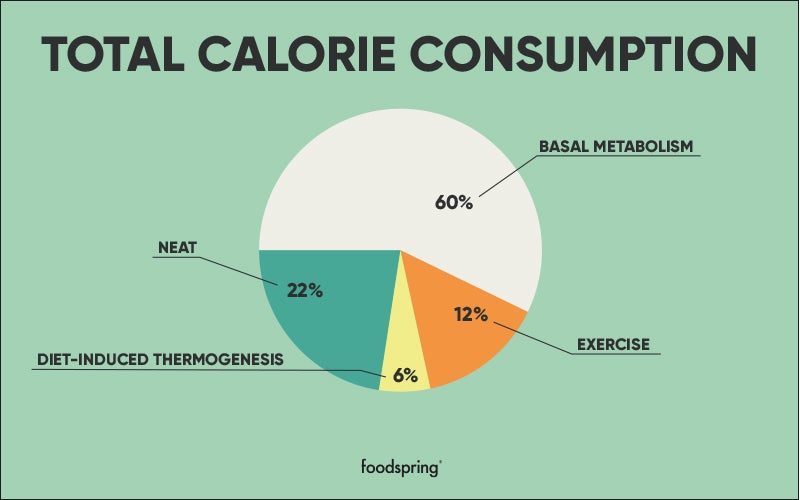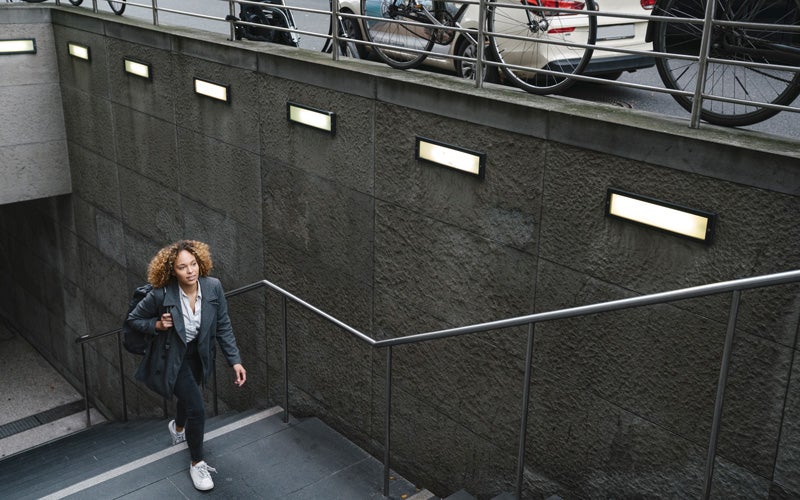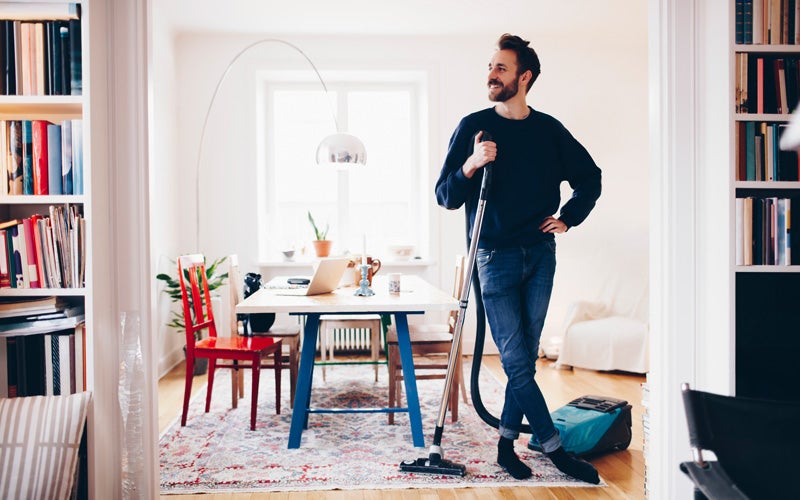The Most Effective Way to Burn More Calories—Without Even Thinking About It
 ©Moyo Sudio
©Moyo Sudio
NEAT is your key to burning more calories without even thinking about them. Bonus: you’ll start leading a healthier and more active life as well. No extra sports needed. Curious? Stick with us and find out our simple ways to use more energy in your everyday life. But before we get started, let us give you a tip. Next time you’re sitting on the couch and reach for a snack, make it our Protein Balls. Each ball is made up of a full 20% protein. And 100% flavor. You wouldn’t expect less from us.
As a quick note: All of these tips are aimed at able-bodied people who can easily add more physical activity to their routines. If you have a chronic condition, disability, or other concerns about these activities, talk to a trusted medical advisor before adding more activity to your daily routine.
What Does NEAT Actually Mean?
When we’re talking about your metabolism, NEAT stands for “Non-Exercise Activity Thermogenesis.” It’s a quick way of labeling the calories you burn by moving throughout the day, when you’re not at the gym or otherwise exercising.

Things that contribute to your total NEAT non exercise activity include going to the office, cooking, shopping, walking the dog, housework, and basically any other casual movements you do without the explicit goal of training.
Calculate NEAT – How Many Calories Can You Burn
How many calories NEAT burns isn’t easy to calculate with a formula. After all, your NEAT depends on how much you move throughout the day. Age, gender, and your overall fitness and health will also contribute to your total energy expenditure.
To get an idea of the NEAT part of your daily calories burned, take a look at your daily physical activity. How many steps do you walk per day? How much do you ride your bike? Do you stand a lot? How many ways do you move that have nothing to do with the gym?
The percentage of total calories burned through NEAT varies between about 15% and 30% depending on your lifestyle.

NEAT Isn’t Everything – Understanding Calorie Needs
Calculating calorie totals can be confusing, so let’s clarify a couple of things right away. NEAT is not to be confused with your metabolism or the afterburn effect. Your daily energy expenditure is made up of several different metabolic processes.
-
Basal Metabolic Rate (BMR)
Your basal metabolic rate refers to the calories the human body needs to maintain all its essential functions – without moving. This includes, for example, breathing, maintaining your organs, and supplying your muscles with nutrients. That’s why your BMR usually goes up as your fitness improves.
-
Thermic Effect of Food (TEF)
This kind of thermogenesis includes all the calorie expenditure that comes from eating something. Sounds contradictory at first, but you have to process that food somehow, and that also requires some energy in itself.

Food needs to be broken down into its individual components, nutrients must be transported to their destinations, and anything superfluous has to be eliminated. This process requires energy and therefore you burn calories alongside your energy intake.
Our tip: Protein has a higher thermic effect than other macros. So if one of your goals is weight loss or fat loss, pay attention to your protein needs. Getting enough protein despite a calorie deficit also helps prevent muscle loss. Check out our protein snacks to go in our shop!
-
Non-Exercise Activity Thermogenesis (NEAT)
The calories you burn through NEAT are those your body needs for everyday activities like climbing stairs, walking from your desk to the kitchen, doing household chores, fixing your bike, and similar actions.
-
Thermic Effect of Activity (TEA)
Deliberate exercise has an obvious effect on your energy balance, so you burn more calories on workout days than on rest days. Intensive HIIT units, in particular, also keep your metabolism boosted with the afterburn effect.
Tip: Our workout database has tons of free workouts for a variety of goals in the gym or at home!
If you want to figure out your calorie totals for a specific fitness goal, like fat loss or muscle building, why not go for our free Body Check?
Increase Your NEAT – 8 Tips for Burning Calories in Your Daily Routine
Every movement counts with NEAT. No matter how small! Fidgeting in your desk chair, getting off the train one stop earlier, or those 10 minutes of standing in place instead of sitting.
Taken by themselves, they don’t seem like much. But these ways to increase your NEAT add up throughout the day to a significant total.
-
Add Exercise to Your Breaks
How often do you catch yourself a) checking your social-media feeds or b) getting up to grab a snack while working at your desk? If you’re like most of us, the answer is probably “too often.”
And that’s good! Because it’s also your chance to establish a new movement routine.

Always wanted to learn handstands, do more ab workouts, or just stretch more often? Every time you think about whipping out your smartphone or grabbing a snack, do a handstand, 5 crunches, or a little stretch instead.
You can even do your stretches while sitting on your office chair. But you’ll boost your NEAT levels more by standing up (or switching to a standing desk!)
-
Go By Bike or Foot
The classic solution for anyone who wants to move more: Take your bike instead of public transport or driving a car.
Of course more movement is better, but baby steps add up too: Get off the bus one stop earlier, or walk up and down the street after parking. Whatever works for you! And that way you get to decide what physical activity levels are right for you every day.
Tip: Form healthy habits that last with our 7 days to new routines guide!
-
Stand When You Can

Whether you’re on the train, on the phone, in a meeting, or in the office, just stand up instead of sitting whenever possible. Standing burns more calories than sitting, increasing your NEAT. Plus, your cardiovascular health and your muscles will thank you for the change of pace.
-
Take the Stairs
Climbing stairs for 15 minutes burns an average of 120 calories. Think about how many show up in your daily routine. If you take every chance to take the stairs, you’re sure to get to at least 15 minutes.
A nice side effect: taking the stairs is a great lower-body workout. If you mostly use the ball of your foot, your calf muscles have to work. Meanwhile, ff you concentrate on evenly distributing your weight over the whole foot instead, you also train all your thigh and gluteal muscles. Win-win!

-
Walk Your Groceries Home
Carrying shopping bags is Functional Training par excellence, it’s completely free and doesn’t take up any extra time.
Pack your bags to distribute the weight of your groceries evenly between them, and carry them home from the grocery store instead of loading them into your bike basket or car. A fully loaded backpack also counts.
By the way, a bit of weight in your backpack (a liter of water for example) is also a great way to add an extra challenge to climbing a stair or two.
-
Clean Up a Bit More
Imagine your parents are coming to visit. You’d probably have to do at least a little more cleaning than usual. And household chores, especially vacuuming, mopping, and ironing, increase your NEAT significantly.

-
While You’re Waiting… Walk!
Whether it’s passing time at the bus stop when your date is running late, or if you’ve just arrived somewhere too early, talk another walk around the block instead of sitting down right away.
In addition to the effect on your NEAT level, your spine will thank you if you walk a bit between longer periods of sitting.
-
While You’re Doing Everything Else… Walk!
Phone calls, podcasts, chats over coffee. Almost everything can be enjoyed on a walk instead of sitting.
Exercise in the fresh air also strengthens your immune system and gives your eyes and mind a welcome break from screens.
Need more inspiration? Then scroll through our 10 tips for losing weight without working out.
Conclusion
- NEAT stands for Non-Exercise Activity Thermogenesis.
- Moving more throughout your daily routine increases your NEAT.
- Many small movements make a big difference in total.
- The percentage of calories per day burned through NEAT is different for everyone, but on average it’s between 15% and 30%.
- The higher your NEAT, the higher your total calorie needs.
More Facts from foodspring:
- 10 benefits a nature walk can have on your health
- Vegan Protein Bars to go
- 43 Exercises and How Many Calories You’ll Burn
- Calorie Cheat Sheet: Our (Printable) Guide to Help You Track Calories
Sources for this article
We at foodspring use only high-quality sources, including peer-reviewed studies, to support the facts within our articles. Read our editorial policy to learn more about how we fact-check and keep our content accurate, reliable, and trustworthy.

































